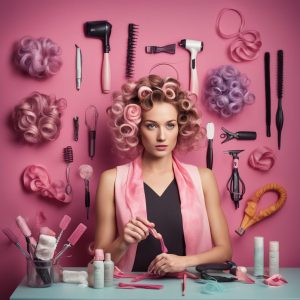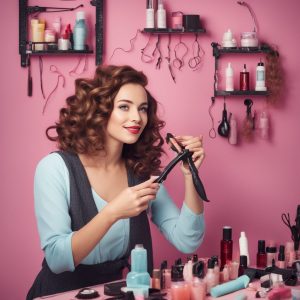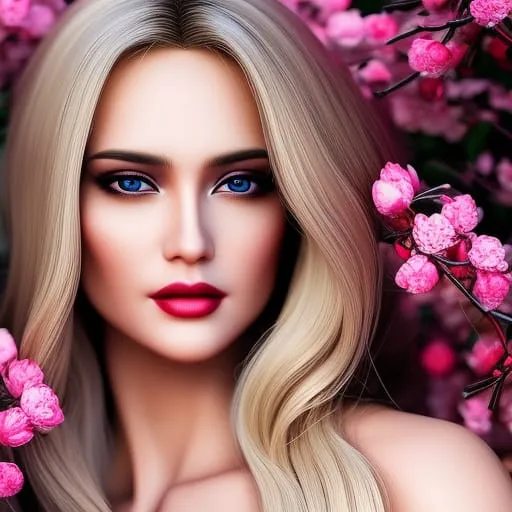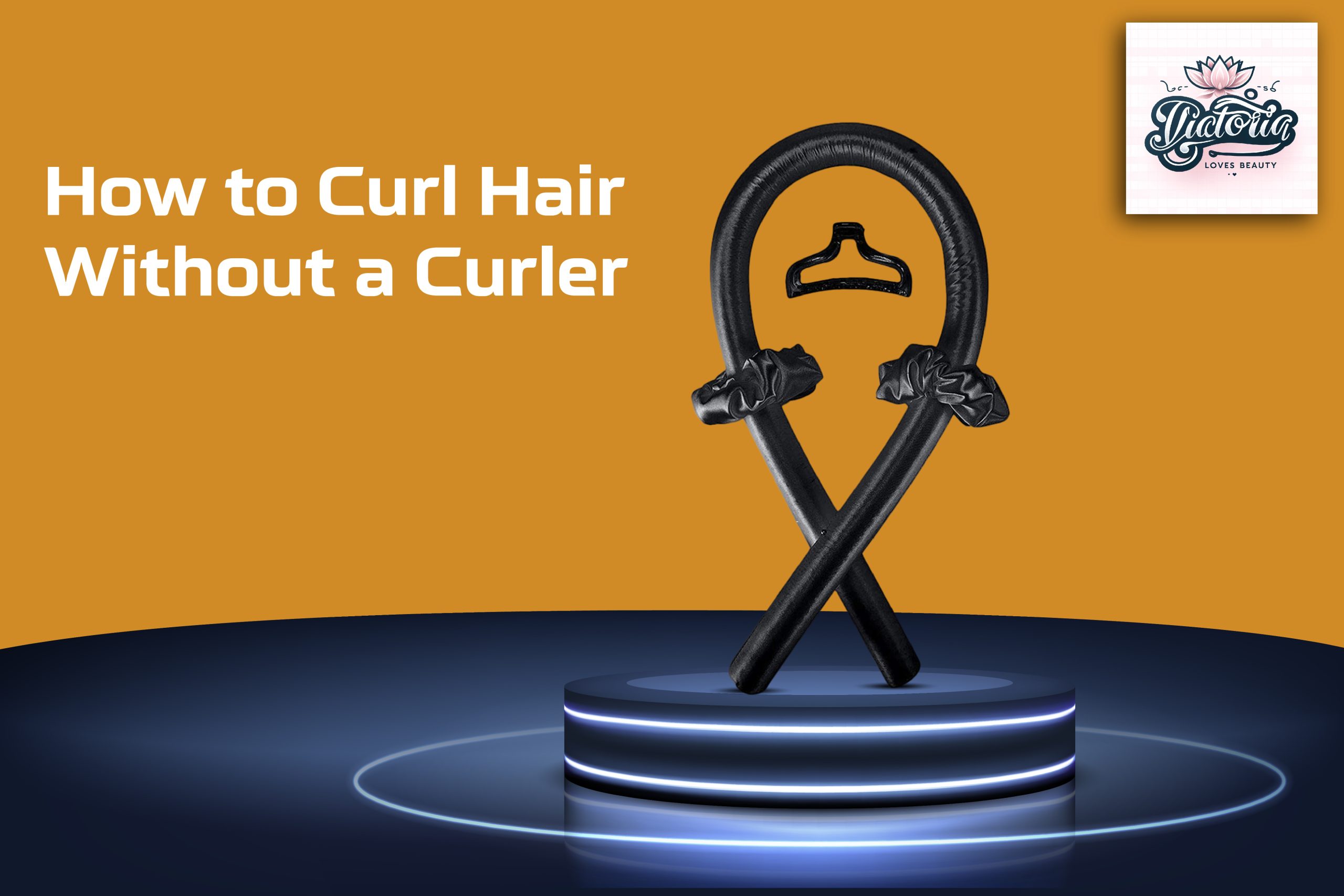Curls add a fun twist to your look, but the heat from curling irons can be damaging. Creating curls can transform your hairstyle, adding volume, texture, and a touch of elegance to your look. Whether you’re aiming for tight ringlets or loose waves, mastering the art of curling your hair is a skill that can elevate your style for any occasion. Luckily, various heatless methods achieve beautiful curls suitable for all hair lengths. Get ready to unlock the secrets of perfect curls and add a new dimension to your style!
Understanding Different Hair Types:
Knowing the distinctive qualities of various hair types is the first step in navigating the world of hair care. Every hair type is different and reacts differently to specific styling and maintenance regimens. This thorough examination of different hair kinds will enable you to recognize and treat your hair more skillfully.
- Straight Hair: This hair type can be thick, coarse, silky, or acceptable. Its natural oils move down the hair shaft fast, giving it a sleek and shining appearance—the requirement for greater volume and oiliness present challenges. Light styling products and routine washing are among the care recommendations to prevent weighting it down.
- Wavy Hair: Between straight and curly, wavy hair frequently has a soft, S-shaped pattern. Hydrating treatments and practices that improve natural wave characteristics without generating frizz are beneficial for wavy hair, which can be described as delicate and thin (2A), medium-textured with more defined waves (2B), or coarse with more pronounced waves (2C).
- Curly Hair: This variety has well-defined, bouncy curls that vary in tightness from very tight spirals (3C) to loose ringlets (3A) to tighter corkscrew curls (3B). Curly hair needs moisture-sealing treatments and frequent hydration because it is prone to frizz and dryness. Styling products that enhance curls and gently detangle hair are crucial.
- Coily Hair: Coily or kinky hair is characterized by tightly curled hair that appears abundant. It can be very tightly coiled with a zigzag pattern (4B), tightly coiled (4A), or densely packed with tiny coils (4C). The most prone type of hair to breakage and dryness is this one. It needs regular hydration, a protective style, and soft handling to keep it healthy.
Risks of Using Heat on Hair:
Using heat on hair, especially frequently or at high temperatures, can lead to several potential risks and damage, including:
- Heat Damage: Regular heat-styling tools like straighteners, curling irons, and blow dryers can cause heat damage. This manifests as dry, brittle hair, split ends, and breakage.
- Loss of Natural Moisture: High temperatures strip hair of its natural oils and moisture, leading to dryness and frizz.
- Altered Hair Texture: Over time, excessive heat can permanently alter your hair’s natural texture, making retaining natural curls or waves more difficult.
- Increased Porosity: Heat can increase hair’s porosity, making it more prone to moisture loss and further damage.
- Color Fading: Heat can accelerate color fading for dyed hair, leading to more frequent touch-ups and additional chemical exposure.
- Scalp Damage: Excessive heat can also harm the scalp, potentially causing dryness, irritation, and dandruff.
- Weakened Hair Shaft: Heat weakens the hair shaft, thinning hair and making it more susceptible to external damage like pollution and UV rays.
- Reduced Hair Elasticity: Heat exposure can reduce hair’s elasticity, making it less flexible and more prone to snapping and breaking.
Benefits of Heatless Curling:
- Reduced Hair Damage: Heatless curling methods are significantly gentler on hair compared to heated tools like curling irons or blow dryers. Regular heat can strip hair of natural oils, leading to dryness, brittleness, and split ends. Heatless techniques reduce the risk of heat-induced damage, helping maintain the hair’s natural integrity and health.
- Long-Term Hair Health: Over time, minimizing heat exposure helps preserve the strength and elasticity of hair. This mainly benefits those with color-treated or chemically processed hair, which is more susceptible to damage.
- Moisture Preservation: Heat styling often removes moisture from hair, making it prone to frizz and breakage. Heatless curls retain the hair’s natural moisture, promoting a shinier and healthier appearance.
- Convenience and Time-Saving: Heatless curling can be more convenient as it often involves setting the hair in curlers, braids, or wraps overnight. This eliminates the need for time-consuming morning styling routines, offering a “set-and-forget” approach.
- Versatility in Styling: Heatless methods can create a wide range of curls, from tight spirals to loose waves, adaptable to various hair lengths and types. This versatility allows for experimenting with different looks without the risk of heat damage.
- Enhanced Hair Texture and Volume: Heatless techniques can help enhance hair’s natural texture, adding volume and fullness without chemical treatments or heat-styling products.
Best DIY Heatless Curls Techniques

T-Shirt Curls
T-Shirt Curls are a unique and hair-friendly method for getting gorgeous, bouncy curls without using heat-styling products. This technique, an excellent substitute for heat damage prevention, uses the pliable, soft fabric of a t-shirt to curl your hair gently. Here are simple steps to achieve t-shirt curls:
- After washing your hair, cut an old T-shirt into long strips.
- Roll a strip with a section of your hair towards your scalp and tie it.
- Repeat with the rest of your hair and let it dry completely.
- This method creates tight or soft curls depending on the strip’s thickness.
Headband Curls for a Retro Look
This no-heat method involves wrapping your hair around a headband to create soft, romantic curls reminiscent of retro glamour. Perfect for those who love a classic look with a modern twist, headband curls are easy to create and gentle on your hair. Whether aiming for a 1920s flapper style or a 1940s Hollywood wave, this technique offers a nostalgic touch to your hairstyling routine. Here is how you can do it:
- Wash and towel dry your hair.
- Place a headband around your head.
- Wrap sections of your hair around the headband, securing it with pins.
- Let your hair dry, then remove the headband and pins to reveal your curls.
Braiding for Natural Waves
One of the most classic and simple ways to get naturally wavy hair is to braid your hair. With this technique, damp hair is braided and then let air dry, creating soft, natural-looking waves with a carefree, bohemian vibe. This is great if you want to give your hair a vacation from heat tools and are searching for a low-maintenance styling option. Follow these steps:
- After washing, make a center parting and create two ponytails.
- Braid these ponytails and secure them.
- Once dry, loosen the braids to enjoy natural waves.
Sock Bun Waves
An innovative and creative way to make graceful, flowing waves without the use of heat is with Sock Bun Waves. Using an old sock as a doughnut-shaped tool, wet hair is wrapped around a sock bun and allowed to set to create beautiful, voluminous waves. This eco-friendly and enjoyable method is quite tempting for people who want a carefree approach to hairstyling. You can get the sock bun waves by following the steps:
- Create a doughnut shape from a cut sock.
- Tie your hair in a high ponytail and roll it into the sock bun.
- Sleep with the bun, and loosen it in the morning for waves.
Easy Waves with Buns
Easy Waves with Buns is a wonderfully easy and efficient method for getting gorgeous, beachy waves without using any heat. This technique is ideal for individuals looking for a quick and straightforward styling option because it emphasizes having a carefree, natural look. Easy Waves with Buns is a fun and fuss-free method to create movement and texture to your hair with little effort, perfect if you’re short on time or want to give your hair a vacation from heat style. Here is how you do it:
- Dampen your hair and part it in the center.
- Twist each section into a bun and let it dry overnight.
- Open the buns in the morning for effortless waves.

Roller Curls
Roller curling is a timeless and adaptable method for producing gorgeous, long-lasting curls and waves. This approach covers many types and preferences, allowing you to achieve everything from loose, glamorous waves to tight ringlets with rollers of different sizes. Roller Curls are a classic method for effortlessly and elegantly creating gorgeously curled hair, whether you’re getting ready for a special event or want to add bounce and volume to your regular look. Follow these steps to get roller curls:
- Use hair rollers after washing your hair.
- Roll sections of damp hair in rollers.
- Let them set for a few hours, then remove for curls.
Twist & Curl
Twist & Curl is a contemporary and effortless styling technique that merges the simplicity of twisting with the elegance of curls. This method involves twisting sections of hair and then curling them, either with or without heat, to create defined, bouncy curls with a natural, textured look. It’s a fantastic choice for those who want to add a playful twist to their hair routine, literally and figuratively. Follow these steps:
- Dry your hair with a towel after washing.
- Twist sections of hair and secure them on top of your head.
- Let them dry overnight for curls.
Legging Curls
Legging curls are a unique and distinctive hairstyle trend that has grown in popularity due to their ease of use and efficiency. With this technique, you may achieve soft, realistic-looking curls without using any heat at all by wearing leggings. This is the perfect answer for those looking for a unique yet compelling way to curl their hair overnight. Legging Curls provides a distinctive method of creating gorgeous waves and curls, making them ideal for people who prioritize ease of use and hair health. Here is a style guide for you:
- Apply leave-in conditioner to moisturize hair.
- Place leggings on your head, wrapping hair sections around each leg.
- Let it set for about 2 hours before releasing.
Bantu Knots
African communities gave birth to the gorgeous and culturally rich hairdo known as “Bantu knots,” which has since spread worldwide. This attractive style creates a distinctive and eye-catching look. In addition to being a stylish accessory, Bantu Knots are a valuable method for creating gorgeous, well-defined curls when untied. They are highly praised for their adaptability, which allows them to look great on a wide range of hair lengths and textures. Curly and oily hair types particularly benefit from their ability to accentuate the natural curl pattern. Here is what you need to do:
- Apply a styling product on dry or damp hair.
- Section the hair and twist each, dividing it into a tight, coiled bun
- Once dry, unravel for vibrant curls.
French Twist
The French Twist is an elegant and timeless hairstyle renowned for its sophistication and versatility. Beyond its classic up-do form, the French Twist can also be ingeniously adapted to create graceful, flowing curls. It’s an excellent option for those seeking a chic and effortless way to curl their hair, combining the finesse of a traditional updo with the charm of loose curls. Here is what you need to do:
- Begin with slightly damp hair and add styling mousse.
- Split your hair into two or more sections, and twist it away from your face, down to the ends.
- Roll the twisted hair into a bun-like shape against your head.
- Use bobby pins to secure the twist in place.
- After some hours, carefully undo the twists and buns, gently shaking your hair to reveal soft, elegant waves.
Hair Plopping
Hair Plopping is a game-changing technique particularly beloved in the curly hair community for enhancing natural curls and reducing frizz. Hair Plopping is especially beloved for its ability to reduce frizz, increase curl definition, and shorten air-drying time, all while keeping the curls intact and beautifully shaped. It’s a game-changer for those seeking to embrace their natural curl pattern without using heat or damaging styling products. Hers is what you should do:
- Start with clean, conditioned hair and apply curl cream.
- Use a cotton t-shirt or a microfiber towel and spread it on a flat surface.
- Bend forward and gently place your hair on the center of the cloth.
- Wrap Your Hair and tuck in the ends, or use a hair tie to secure the wrap.
- Leave the wrap on for about 20-30 minutes, then unwrap.
These methods are ideal for all hair lengths, including short hair. Heatless curling prevents damage and reduces hair fall, split ends, and loss of shine, ensuring healthy and bouncy curls. So, ditch the heat and try these easy, hair-friendly techniques for your next curly hairstyle!

Conclusion
- Healthier Choice: Switch to heatless curling methods to avoid heat damage and promote hair health.
- Diverse Styles: Achieve various looks, from tight ringlets to loose waves, for all hair types and lengths with items like t-shirts, leggings, braids, or buns.
- Simple & Accessible: No need for costly tools or products—use everyday items to create beautiful, natural curls.
- Natural Results: Enjoy a more effortless and voluminous style without the harsh effects of heat.
- Embrace Natural Beauty: Protect and nurture your hair while exploring different styles, embracing your hair’s versatility and health.

Beauty enthusiast, mom on-the-go, and coffee addict (not necessarily in that order!). When she’s not chasing after her adorable toddler, Victoria is busy researching the latest beauty trends, testing out products, and sharing her discoveries with the world. Join her on this journey of self-care, empowerment, and finding your own unique spark of beauty!
